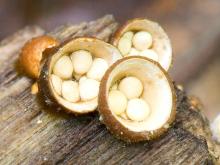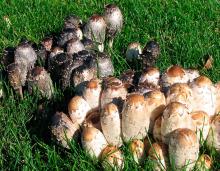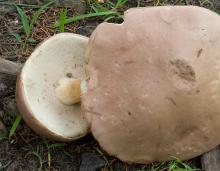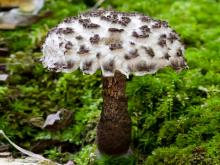Mushrooms
Media

Species Types
Scientific Name
Lactarius volemus
Description
The voluminous-latex milky has a velvety, orangish brown cap and stalk, white gills and flesh that exude a milky white latex, and a fishlike odor. It grows scattered in deciduous woods.
Species Types
Scientific Name
Amanita flavoconia
Description
The cap of this mushroom ranges from orange to yellow, with yellowish patches. The stalk has crumbling patches at the base, and a ring. It grows on the ground in mixed woods.
Media

Species Types
Scientific Name
Pleurotus ostreatus and P. pulmonarius
Description
Oyster mushrooms are choice edibles with broad, fleshy, whitish, grayish, or tan caps and a stubby, off-center stalk. They grow clustered on stumps, logs, and trunks.
Media

Species Types
Scientific Name
Sarcoscypha occidentalis
Description
The stalked scarlet cup is, indeed, a tiny red cup on a tiny white stalk. It grows scattered on fallen wet sticks and branches in damp deciduous woods.
Media

Species Types
Scientific Name
Crucibulum laeve
Description
Splash cups have small brown cups holding tiny “eggs” that are each attached to the “nest” by a cord. They grow in clusters on dead wood, debris, wood chips, and mulch.
Media

Species Types
Scientific Name
Coprinus comatus
Description
The shaggy mane has a white, shaggy, cylindrical cap that turns black and inky. It often grows in large numbers along roadsides and in lawns and disturbed areas.
Media

Species Types
Scientific Name
Lycoperdon perlatum
Description
The gem-studded puffball is a white, rounded to turban-shaped ball, densely covered with spiny warts, developing a pore at the top. It grows on the ground in open woods, along roads, in waste areas.
Media

Species Types
Scientific Name
Boletus pallidus
Description
The pallid bolete has a pale cream to buff cap and stalk and pale cream-yellow pores. It grows singly or in groups of up to several, on the ground in oak woods.
Media

Species Types
Scientific Name
Strobilomyces floccopus
Description
The old man of the woods has a grayish black, shaggy cap with grayish pores and a grayish black, shaggy stalk. It usually grows singly, on the ground in mixed hardwood forests.
Media

Species Types
Scientific Name
Daedaleopsis confragosa (Daedalea confragosa)
Description
The thin-maze flat polypore is a grayish brown bracket fungus with a zoned top and a furrowed, mazelike underside. It grows singly or in small, layered clusters on dead wood or in wounds of living trees.
See Also



Media

Species Types
Scientific Name
Monotropa hypopitys
Description
Pinesap is a plant that puts the "wild" in wildflower! It lacks chlorophyll, so its roots connect to fungi underground and absorb nutrients from the fungi.
Media

Species Types
Scientific Name
Cladophora, Pithophora, and Spirogyra spp., and others
Description
Filamentous green algae forms green, cottony masses that are free-floating or attached to rocks, debris, or other plants.
Media

Species Types
Scientific Name
Monotropa uniflora
Description
Indian pipe lacks chlorophyll, so it is white, not green. Below ground, its roots join with fungi that connect to tree roots. This plant, then, takes nourishment indirectly from the trees.
About Mushrooms in Missouri
Mushrooms are a lot like plants, but they lack chlorophyll and have to take nutrients from other materials. Mushrooms are neither plants nor animals. They are in a different kingdom — the fungi. Fungi include the familiar mushroom-forming species, plus the yeasts, molds, smuts, and rusts.
Always be cautious when eating edible mushrooms. Be absolutely sure of the ID, and only eat a small amount the first time you try it to avoid a reaction..





















